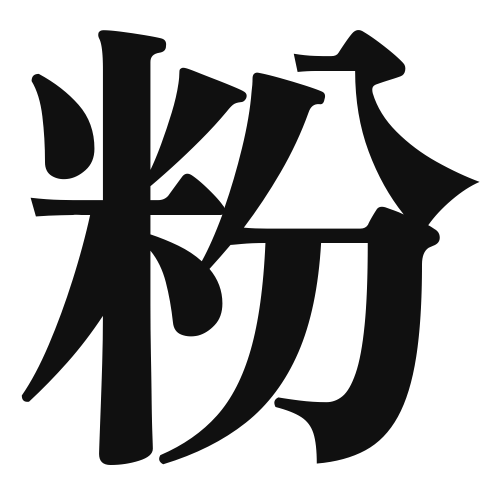1. Overview of Meaning
The kanji “粉” (pronounced “fun” or “kona”) means “powder” or “flour.” It refers to a fine, dry substance made by grinding or crushing solid materials, commonly used in cooking and baking.
2. Formation and Radical
Formation of the Kanji: The kanji “粉” is a phonetic-ideographic character (形声文字). It combines the radical for “stone” (石) on the left, which relates to grinding, and the phonetic component “分” (pronounced “bun”), which contributes to its pronunciation.
Radical: The radical of “粉” is 石 (ishi), meaning “stone,” indicating its connection to the process of grinding materials into powder.
3. Examples of Usage
Common Words and Phrases: Some frequently used words that include “粉” are:
- 小麦粉 (こむぎこ, komugiko) – wheat flour
- 粉末 (ふんまつ, funmatsu) – powder
- 粉雪 (こなゆき, konayuki) – powdery snow
Example Sentences in Daily Conversation:
- このケーキには小麦粉が必要です。 (This cake requires wheat flour.)
- 粉雪が降っています。 (Powdery snow is falling.)
4. Synonyms and Antonyms
Similar Kanji: A similar kanji is “粒” (つぶ, tsubu), which means “grain” or “particle.” While “粉” refers to a fine powder, “粒” indicates larger, individual pieces.
Antonyms: An antonym for “粉” could be “塊” (かたまり, katamari), meaning “lump” or “clump,” which refers to a solid mass rather than a fine powder.
5. Cultural and Historical Background
Connection to Japanese Culture: In Japanese culture, “粉” is significant in traditional cooking, especially in making rice flour and various types of noodles. It plays a crucial role in many Japanese dishes.
Proverbs and Idioms: One common saying is “粉骨砕身” (ふんこつさいしん, funkotsusaishin), which means to dedicate oneself fully to a task, literally translating to “to grind one’s bones to powder.” This reflects the cultural value of hard work and perseverance.
